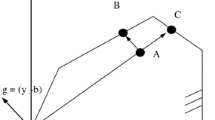Abstract
We examine the implications of the US government’s too-big-to-fail (TBTF) policy as it has been applied to banks. Using alternative measures of risk, we compare the risk-taking behavior of 11 TBTF banks, identified by the Comptroller of the Currency in 1984, to a number of non-TBTF banks. We provide both theory and new empirical evidence to support our argument that the TBTF policy leads management to significantly increase risk-taking, with no corresponding increase in performance. While prior studies have considered the effects of the TBTF policy on limited, but risk-related aspects of bank behavior, such as the cost of funds, our study provides direct evidence about the risk-taking behavior associated with the TBTF policy. Our study has important implications for the current political debate regarding the too-big-to-fail policy.
Similar content being viewed by others
Notes
ROE = (R/E)*(A/A) = (R/A)*(A/E), where R is the returns, E is the equity, and A is the Assets.
References
Akerlof, G. A., & Romer, P. M. (1993). Looting: The economic underworld of bankruptcy for profit. Brookings papers on economic activity, no. 2, pp. 1–73.
Altman, E. I. (1968). Financial ratios, discriminant analysis and the prediction of corporate bankruptcy. Journal of Finance, 23(4), 589–609.
Anderson, R. C., & Fraser, D. R. (2000). Corporate control, bank risk taking, and the health of the banking industry. Journal of Banking & Finance, 24(8), 1383–1398.
Beja, A. (1972). The structure of the cost of capital under uncertainty. Review of Economic Studies, 38(3), 359–368.
Benston, G. J., & Kaufman, G. G. (1998). Deposit insurance reform in the FDIC Improvement Act: The experience to date. Economic Perspectives, 22(2), 2–20.
Brewer, E., & Jagtiani, J. (2009). How much did banks pay to become too-big-to-fail and to become systemically important? Federal Reserve Bank of Philadelphia Working Paper Series, Philadelphia.
Bromiley, P. (1991). Testing a causal model of corporate risk taking and performance. Academy of Management Journal, 34(1), 37–59.
Cannella, A. A. J., Fraser, D. R., & Lee, S. (1995). Firm failure and managerial labor markets: Evidence from Texas banking. Journal of Financial Economics, 38(2), 185–210.
Certo, S. T., Daily, C. M., Cannella, A. A., Jr., & Dalton, D. R. (2003). Giving money to get money: How CEO stock options and CEO equity enhance IPO valuations. Academy of Management Journal, 46(5), 643–653.
Chang, S.-J., Chung, J., & Moon, J. J. (2013). When do wholly owned subsidiaries perform better than joint ventures? Strategic Management Journal, 34(3), 317–337.
Chatterjee, S., Hadi, A. S., & Price, B. (2000). Regression analysis by example. New York: Wiley.
Coles, J. W., & Hesterly, W. S. (2000). Independence of the chairman and board composition: Firm choices and shareholder value. Journal of Management, 26(2), 195–214.
Eisenhardt, K. M. (1989). Agency theory: An assessment and review. Academy of Management Review, 14(1), 57–74.
FDIC. (1997). History of the Eighties—Lessons for the future, vol. 1: An examination of the banking crisis of the 1980s and early 1990s. Washington, DC: FDIC.
Fields, L. P., Fraser, D. R., & Wilkins, M. S. (2004). An investigation of the pricing of audit services for financial institutions. Journal of Accounting and Public Policy, 23(1), 53–77.
Finkelstein, S., & D’Aveni, R. A. (1994). CEO duality as a double-edged sword: How boards of directors balance entrenchment avoidance and unity of command. Academy of Management Journal, 37(5), 1079–1108.
Flammer, C., & Kacperczyk, A. (2015). The impact of stakeholder orientation on innovation: Evidence from a natural experiment. Management Science, 61(11), 2549–2568.
Flannery, M. J., & Sorescu, S. M. (1996). Evidence of bank market discipline in subordinated debenture yields: 1983–1991. The Journal of Finance, 51(4), 1347–1377.
Gilson, S. C. (1990). Bankruptcy, boards, banks, and blockholders: Evidence on changes in corporate ownership and control when firms default. Journal of Financial Economics, 27(2), 355–387.
Huang, X., Zhou, H., & Zhu, H. (2011). Systemic risk contributions. Washington, DC: Federal Reserve Board.
Jensen, M. C., & Meckling, W. (1976). Theory of the firm: Managerial behavior, agency costs, and ownership structure. Journal of Financial Economics, 3, 305–360.
Kang, E. (2006). Investors’ perceptions of managerial opportunism in corporate acquisitions: The moderating role of environmental conditions. Corporate Governance: An International Review, 14(5), 377–387.
Koch, T. W., & MacDonald, S. S. (2007). Bank management. Mason, OH: South-Western Cengage Learning.
Lin, X., & Zhang, Y. (2009). Bank ownership reform and bank performance in China. Journal of Banking & Finance, 33(1), 20–29.
Meltzer, A. (2012, May 16). Banks need more capital, not more rules. The Wall Street Journal.
O’Hara, M., & Shaw, W. (1990). Deposit insurance and wealth effects: The value of being “too big to fail”. The Journal of Finance, 45(5), 1587–1600.
Pathan, S. (2009). Strong boards, CEO power and bank risk-taking. Journal of Banking & Finance, 33(7), 1340–1350.
Penas, M. F., & Unal, H. (2004). Gains in bank mergers: Evidence from the bond markets. Journal of Financial Economics, 74(1), 149–179.
Saunders, A., Strock, E., & Travlos, N. G. (1990). Ownership structure, deregulation, and bank risk taking. Journal of Finance, 45(2), 643–654.
Sharpe, W. F. (1964). Capital asset prices: A theory of market equilibrium under conditions of risk. The Journal of Finance, 19(3), 425–442.
Stiroh, K. J. (2006). New evidence on the determinants of bank risk. Journal of Financial Services Research, 30(3), 237–263.
US Department of Treasury. (2012). The finanical crisis response: In charts. Washington, DC: US Department of Treasury.
Wahlen, J. M. (1994). The nature of information in commercial bank loan loss disclosures. The Accounting Review, 69(3), 455–478.
White, H. (1980). A heteroskedasticity-consistent covariance matrix estimator and a direct test for heteroskedasticity. Econometrica, 48, 817–830.
Wright, P., Ferris, S. P., Sarin, A., & Awasthi, V. (1996). Impact of corporate insider, blockholder, and institutional equity ownership on firm risk taking. Academy of Management Journal, 39(2), 441–563.
Zhou, C. (2009). Are banks too big? DNB working paper, no. 232.
Author information
Authors and Affiliations
Corresponding author
Rights and permissions
About this article
Cite this article
Zardkoohi, A., Kang, E., Fraser, D. et al. Managerial Risk-Taking Behavior: A Too-Big-To-Fail Story. J Bus Ethics 149, 221–233 (2018). https://doi.org/10.1007/s10551-016-3133-7
Received:
Accepted:
Published:
Issue Date:
DOI: https://doi.org/10.1007/s10551-016-3133-7




